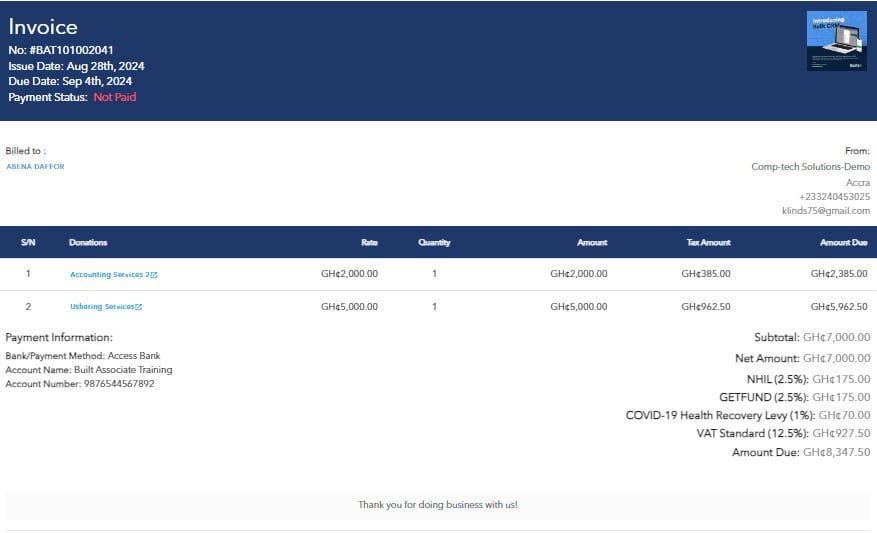
How to Write an Invoice for Your Small Business
Whether you’re a business owner, freelancer, sole proprietor, or run a nonprofit organization, knowing how to write an invoice for your small business is essential to ensuring you get paid.
This can directly lead to quicker payments and a healthy cash flow.
For new business owners, writing invoices can be challenging. However, Built now offers easy-to-use templates and customization options, making the process much simpler.
What is an invoice?
An invoice is a document that a seller sends to a buyer to request payment for goods or services.
It includes details such as the products or services, quantities, prices, total amount due, and both parties’ contact information. It also provides the invoice number, issue date, payment terms, and due date.
The main purpose of an invoice is to facilitate payment and serve as a record for both the seller and the buyer.

Sample of an invoice
Here are some key differences between an invoice and a quote
- An invoice is issued after the transaction has occurred, once the goods or services have been delivered or completed, to formally request payment. In contrast, a quote is issued at the start of the sales process, typically before any goods or services are provided.
- An invoice provides detailed information about the goods or services delivered, including quantities, final prices, the total amount due, payment terms, and payment instructions, and a quote outlines estimated prices, product or service descriptions, quantities, and sale terms.
- An invoice serves as a bill and a demand for payment. It is used to collect the agreed-upon amount for the goods or services that have been provided. On the other hand, a quote informs the customer about the expected costs and terms before they commit to purchasing.
What to Include in an Invoice
While invoice formats may differ, there are standard practices for what should be included in an invoice.
- Header: Includes your company name, logo, and an “Invoice” label.
- Contact Information: Lists your business’s and the client’s details (name, address, phone, email).
- Invoice Details: Shows the unique invoice number, issue date, and payment due date.
- Itemized List: describes each product or service, including quantity, unit price, and total price.
- Subtotal: The total of itemized costs before taxes and discounts.
- Taxes: Any applicable taxes (e.g., sales tax or VAT).
- Discounts: Any discounts applied to the total amount.
- Total Amount Due: The final amount after taxes and discounts.
- Payment Terms: Accepted payment methods (e.g., bank transfer, credit card, PayPal) and payment terms (e.g., a week, a month/net 30, 90 days, etc. ).
- Notes/Special Instructions: Additional information like a thank you note or specific payment instructions.
How to Write an Invoice
Let’s take a closer look at how to create one for your small business.
1. Use a professional template.
We recommend using and customizing pre-designed templates from software like Built, Microsoft Word, or Excel to create a professional design
A clean design helps your new company be taken more seriously and boosts brand awareness when you add branding elements such as your logo or company colors.
2. Add your business information.
At the top of your invoice, add your business name, logo, address, phone number, and email. This makes your invoice look professional and helps your clients easily identify and contact you. Include:
- Your company’s name, address, and contact details
- Your contact person’s name
- Your client’s company name and address
3. Invoice Number
Adding invoice details is essential for creating an invoice. This part shows when the payment is due, which helps you keep track and refer back later.
Use a numbering system that works for your business, like sequential numbers or a mix of numbers and letters. Make sure these details are clearly visible on the invoice.
Include the payment terms and due date so clients know when and how to pay.
4. Itemized List of Products or Services
Standard invoices feature an itemized list of all charges you expect your client to pay. Each line item should include a description of the services or goods provided, a brief description, quantity, and unit price.
Example:
| Description | Quantity | Unit Price | Total |
| Web design services | 10 hours | $50/hour | $500 |
| Logo design | 1 | $200 | $200 |
| Hosting fee | 1 year | $100 | $100 |
5. Subtotal, Taxes, and Total Amount Due
To show if you’re charging sales tax, first calculate the subtotal of all items, then add any taxes. Clearly state the total amount due at the bottom of the invoice to avoid confusion.
You don’t always need to include tax on an invoice.
For example, invoices for services usually don’t include tax, but invoices for products might.
6. Payment Terms and Methods
Clearly outline your payment terms, such as Net 30 (payment due in 30 days) , and specify the accepted payment methods. Various payment options can be offered when creating an invoice, including:
- Mail (for cash or check)
- Credit/debit card
- Online payment (such as Built Wallet)
7. Additional Notes
Add any additional information or terms, such as late payment penalties, discounts for early payment, or warranties, and include a thank you note to your customers for their business. This will help build a positive working relationship over time.
Conclusion
Creating clear and professional invoices is key to business success. Though it may seem challenging for new business owners, the right tools make it easy. To streamline invoicing, track debtors, and maintain accurate records, use accounting software like Built.
Built allows you to create, customize, and share invoices via email, SMS, or social media effortlessly
